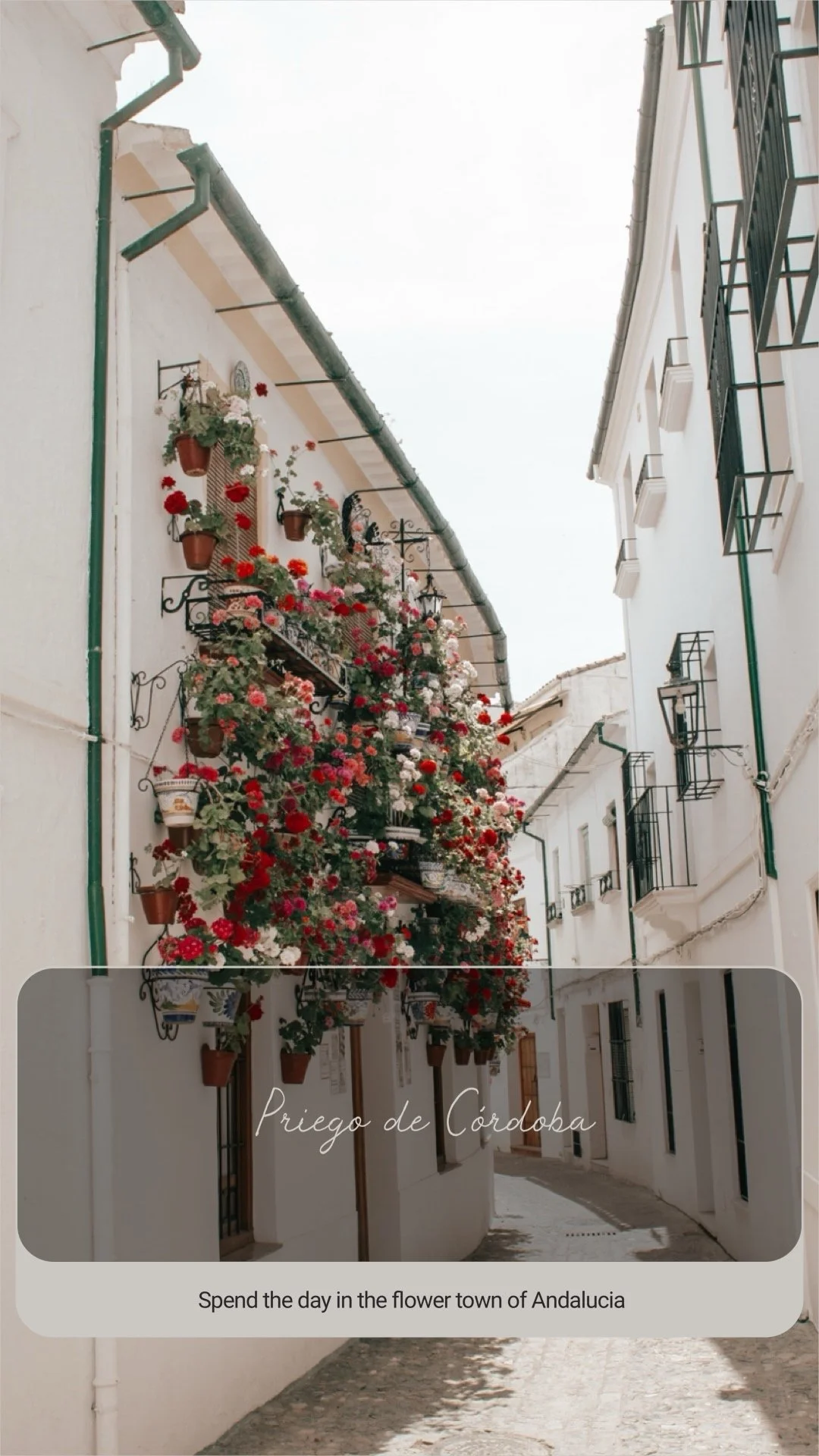A day in Priego de Córdoba, Andalucia’s flower town
Priego de Córdoba is a beautiful and historic town nestled in the Subbética Mountains of southern Spain, in the province of Córdoba, Andalusia. Known as “the jewel of the Baroque” and often called the “flower town”, Priego is famous for its elegant Baroque churches, charming whitewashed streets, and patios overflowing with colorful flowers.
The town’s old quarter, Barrio de la Villa, is a labyrinth of narrow alleys, wrought-iron balconies, and blooming geraniums, reflecting its Moorish and medieval heritage. Priego is also a center for extra-virgin olive oil production, earning international acclaim for its quality and flavor.
Surrounded by olive groves and close to the natural beauty of the Sierras Subbéticas Natural Park, Priego de Córdoba offers a perfect blend of history, culture, and scenic landscapes—making it a must-visit gem in inland Andalusia.
A day in Priego de Córdoba feels like stepping into a living postcard—slow, sun-drenched, and filled with unexpected beauty around every corner. We began our wanderings in the heart of the old town, where time seems to soften its pace. The Barrio de la Villa, Priego’s historic Moorish quarter, is a maze of narrow cobbled streets, whitewashed houses, and balconies spilling over with flowers—vivid red geraniums, pink bougainvillea, and soft purple petunias that catch the Andalusian light just right.
Each turn brought a new little surprise—a blue door framed in jasmine, a sleepy cat stretched on a windowsill, the distant sound of a church bell echoing off stone walls. We didn’t follow a map. We just let the streets lead us, passing small plazas shaded by orange trees, old fountains, and hand-painted ceramic street signs that told us we were in no rush at all.
At one point, we stumbled onto a lively market set up in the town’s central piazza, a happy accident. The square was full of stalls brimming with brass goods, handmade glassware, colorful ceramics, and vintage trinkets—the kind of market where every piece feels like it has a story. Locals chatted, children ran between tables, and the smell of roasted nuts and fresh pastries hung in the air.
Not far from there, we found ourselves at the Balcón del Adarve, a stunning viewpoint right on the cliff’s edge, offering sweeping views of the rolling olive groves and distant hills of the Subbética Natural Park. It’s the kind of place where you can lean on a stone railing and feel like the whole landscape is exhaling with you.
No itinerary, no rush—just the simple joy of discovering beauty in every corner. Priego de Córdoba doesn’t demand your attention. It quietly wins your heart.
1. Barrio de la Villa (Old Town)
The oldest part of Priego, this maze of narrow, whitewashed streets is full of flower-covered balconies, cobblestones, and hidden courtyards.
It's perfect for a slow stroll and offers some of the town’s most photogenic corners.
2. Balcón del Adarve
A dramatic cliffside promenade with stunning panoramic views of the surrounding olive groves and mountains.
Lined with historic stone walls, benches, and flowerpots, it's a peaceful place to sit and soak in the scenery.
3. Priego Castle (Castillo de Priego)
A medieval fortress with a prominent Tower of Tribute (Torre del Homenaje).
Offers insight into the town’s Moorish and Christian history, and the views from the top are worth the climb.
4. Church of La Asunción (Iglesia de la Asunción)
A mix of Gothic and Baroque styles, with one of the most impressive Baroque sacristies in Spain (the Capilla del Sagrario).
The interior is richly decorated with elaborate stucco work and gold leaf.
5. Church of La Aurora (Iglesia de la Aurora)
A lovely 18th-century church built over a former mosque, known for its rococo interiors and devotion to the Brotherhood of the Aurora, who still sing traditional hymns in the streets.
6. Church of San Francisco and the Inmaculada Camarín
Houses the Camarín de la Inmaculada, an elaborately decorated dressing room of the Virgin—one of Andalusia’s most exquisite religious art pieces.
7. Fuente del Rey (King’s Fountain)
A large 19th-century monumental fountain with over 100 spouts and stone carvings, including figures of Neptune and sea creatures.
It’s right next to Fuente de la Salud, a more ancient fountain surrounded by trees and local legends.
8. Mercado de Abastos (Food Market)
A lively local market, especially vibrant on weekends, where you can find fresh produce, local olive oil, cheeses, spices, and more.
Sometimes, local artisans also sell ceramics, brassware, and handmade goods.
9. Olive Oil Tasting
Priego is part of a Denomination of Origin (D.O.) for extra virgin olive oil, considered some of the best in the world.
Visit local producers like Aceites Vizcántar or Almazaras de la Subbética for tastings and tours.
10. Museo Histórico Municipal
Housed in the Casa Museo de Niceto Alcalá-Zamora, a former Spanish president born in Priego.
The museum showcases local history from prehistoric to Roman and medieval times.






















